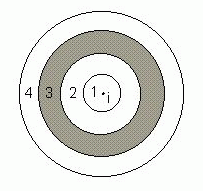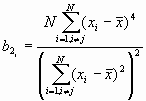Local Moranís I is a local spatial autocorrelation statistic based on the Moranís I statistic. It was developed by Anselin(1995) as a local indicator of spatial association or LISA statistic. Anselin defines LISA statistics as having the following two properties:
Input
Analysis
Analysis is very similar to that of global Moranís I. Values of Ii that exceed E[Ii] indicate positive spatial autocorrelation, in which similar values, either high values or low values are spatially clustered around point i. Values of Ii below E[Ii] indicate negative spatial autocorrelation, in which neighboring values are dissimilar to the value at point i. Again, a normally distributed Z statistic (2-tailed) is calculated to determine significance.
There are two types of spatial weighting methods that may be used (#4 above, under input):
Figure1: Analysis by Bands

In this example, Ii gives the statisticís value for the association between i and all j points in band 3.
Formula
![]()
Where

And
![]()
Remember, when this weighting scheme is used, the statistic is calculated for bands only. A spatial weights matrix may also be used.
For a randomization hypothesis, the expected value is

The variance is

Where

Output
The output file includes the input data file and the total number of points. For each specified distance the following table is printed.
|
Observation # |
Observed Ii |
Expected Ii |
Variance |
Z-value |
|
1 2 ⋮ |
Example
For this example we will consider the same data that are used for the Moranís I and Gearyís c example. Recall that we are examining the distribution of hepatitis rates for the counties of California. A complete listing of the data is included in the Moranís I and Gearyís c example. A map of California showing the Hepatitis rates is shown in Figure 2.
Figure 2: Hepatitis Rates of California Counties in 1998 (per 100,000 pop.)

In this analysis, using Local Moranís I, we will look for spatial association around each individual location. We will use a contiguity matrix as our spatial weighting scheme. The statistically significant Ii are shown in Table 1, and Table 2 is the complete listing of Ii values.
Table 1: Ii results for selected counties
|
County |
Observation # |
Ii |
E[ Ii] |
Variance |
Z-value |
|
Del Norte |
8 |
44.4954 |
-0.0351 |
1.2844 |
39.2923 |
|
Shasta |
45 |
11.5026 |
-0.1053 |
3.7221 |
6.0167 |
|
Humboldt |
12 |
9.1911 |
-0.0702 |
2.5251 |
5.8282 |
|
Siskyou |
47 |
8.5660 |
-0.0877 |
3.1290 |
4.8921 |
|
Trinity |
53 |
3.9381 |
-0.0877 |
3.1290 |
2.2759 |
It appears from the map that there is a grouping of high hepatitis rates in the northwest corner of California. The Local Moranís I analysis can be used to confirm that there is positive spatial autocorrelation in this area. In fact, we find that the five counties with significant Ii are located in this part of the state. We can conclude from this analysis using Local Moranís I that there is a clustering of high hepatitis rates, and that it includes these five counties.
Table 2: Output File
The input data file: hep.dat
The total number of points: 58
The weight matrix file is ca.mat
# Moran's Ii Expected I Variance Z-value
1 0.8837 -0.1053 3.7221 0.5126
2 1.8892 -0.0877 3.1290 1.1176
3 1.2223 -0.0877 3.1290 0.7406
4 0.0411 -0.1053 3.7221 0.0758
5 1.1651 -0.0877 3.1290 0.7082
6 0.2009 -0.0877 3.1290 0.1632
7 0.3317 -0.0877 3.1290 0.2371
8 44.4954 -0.0351 1.2844 39.2923
9 0.3256 -0.0702 2.5251 0.2491
10 -0.6235 -0.1404 4.8753 -0.2188
11 0.0405 -0.0877 3.1290 0.0725
12 9.1911 -0.0702 2.5251 5.8282
13 -0.1891 -0.0351 1.2844 -0.1359
14 0.1420 -0.0877 3.1290 0.1298
15 0.1043 -0.1404 4.8753 0.1108
16 0.4835 -0.0877 3.1290 0.3229
17 0.1352 -0.1053 3.7221 0.1246
18 1.6039 -0.0702 2.5251 1.0535
19 0.6348 -0.0702 2.5251 0.4437
20 -0.0906 -0.0877 3.1290 -0.0016
21 -0.1857 -0.0351 1.2844 -0.1329
22 0.9326 -0.0702 2.5251 0.6311
23 -0.5525 -0.1053 3.7221 -0.2318
24 0.9810 -0.1053 3.7221 0.5631
25 1.7040 -0.0526 1.9102 1.2710
26 0.3364 -0.0877 3.1290 0.2398
27 0.5522 -0.0877 3.1290 0.3618
28 0.4651 -0.0702 2.5251 0.3368
29 -1.1022 -0.0526 1.9102 -0.7594
30 0.5609 -0.0702 2.5251 0.3971
31 -0.0466 -0.0877 3.1290 0.0233
32 -1.0320 -0.1053 3.7221 -0.4804
33 -0.0571 -0.0702 2.5251 0.0082
34 -0.0260 -0.1404 4.8753 0.0518
35 0.6128 -0.0877 3.1290 0.3960
36 0.1537 -0.0702 2.5251 0.1409
37 0.1858 -0.0702 2.5251 0.1611
38 -1.7069 -0.0702 2.5251 -1.0300
39 0.8753 -0.1228 4.3042 0.4811
40 0.8197 -0.0702 2.5251 0.5600
41 0.2681 -0.0702 2.5251 0.2129
42 0.5061 -0.0526 1.9102 0.4043
43 1.7154 -0.1228 4.3042 0.8860
44 0.5447 -0.0702 2.5251 0.3869
45 11.5026 -0.1053 3.7221 6.0167
46 0.2991 -0.0702 2.5251 0.2324
47 8.5660 -0.0877 3.1290 4.8921
48 0.7069 -0.0877 3.1290 0.4492
49 0.6700 -0.0877 3.1290 0.4284
50 0.6463 -0.1228 4.3042 0.3707
51 -0.1200 -0.1053 3.7221 -0.0077
52 1.2646 -0.1053 3.7221 0.7100
53 3.9381 -0.0877 3.1290 2.2759
54 0.1417 -0.0702 2.5251 0.1333
55 1.2367 -0.1053 3.7221 0.6956
56 0.5148 -0.0526 1.9102 0.4106
57 0.3960 -0.1053 3.7221 0.2598
58 0.1348 -0.1053 3.7221 0.1244
References
Anselin, L. (1995) "The Local Indicators of Spatial Association Ė LISA", Geographical Analysis, 27: 93-115.
State of California Department of Health Services (1999). 1998 Report Health Data Summaries for California Counties.